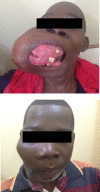Central Myxoma / Myxofibroma of the Jaws: A Clinico-Epidemiologic Review
- PMID: 28229061
- PMCID: PMC5307303
Central Myxoma / Myxofibroma of the Jaws: A Clinico-Epidemiologic Review
Abstract
Introduction: Myxomas are a group of benign rare tumors of connective-tissue origin that occur in both hard (central) and soft tissues of the body. The aim of this study is to highlight our experience in the management of central myxoma of the jaw, with emphasis on its clinic-epidemiologic features as seen in our environment.
Materials and methods: All patients who were managed for central myxoma of the jaw at the Oral and Maxillofacial Surgery department of a regional University Teaching Hospital between September 1997 and October 2015 were retrospectively studied. Details sourced included age, sex, site of tumor, duration, signs/symptoms, treatment given, and complications. Data were analyzed using Statistical Package for Social Sciences (SPSS) version 16 (SPSS Inc., Chicago, IL, USA) and Microsoft Excel 2007 (Microsoft, Redmond, WA, USA). Results from descriptive statistics were represented in the form of tables and charts, with a test for significance (ρ) using Pearson Chi-square (χ2) set at 0.05.
Results: A total of 16 patients were managed within the period reviewed, consisting of 10 (62.5%) females and six (37.5%) males, giving a male-to-female ratio of 1:1.7. The ages of patients ranged from 5 to 70 years, with a mean of 27.06±15.45 years. The mandible accounted for nine (56.3%) cases and the maxilla for six (37.5%) cases, while a combination of the maxilla and the zygoma were involved in one (6.3%) case. Bucco-lingual or bucco-palatal expansion were the most common presentation (six [46.2%] cases each). Histological assessment of tissue specimens showed that fibromyxoma accounted for seven (43.8%) cases, while the remaining nine (56.3%) cases were diagnosed as myxoma. All patients had jaw resections, and these consisted of mandibulectomies in nine (60.0%) patients and maxillectomies in six (40.0%) patients. The duration of hospital stay ranged from 5 to 29 days, with a mean of 17.86±7.68 days. Complications were noted in three patients, and all were surgical wound infections.
Conclusion: Most patients in our environment present late with large tumors and are usually not compliant with follow-up review. Thus, a radical approach is favored in most patients.
Keywords: Jaw; Myxofibroma; Odontogenic Myxoma.
Figures






Similar articles
-
[Odontogenic tumors and neoplastic-like changes of the jaw bone. Clinical study and evaluation of treatment results].Folia Med Cracov. 1998;39(1-2):35-141. Folia Med Cracov. 1998. PMID: 10481376 Review. Polish.
-
Clinicopathological characteristics of odontogenic myxoma in Nigerians.West Afr J Med. 2011 Jul-Aug;30(4):255-61. West Afr J Med. 2011. PMID: 22669829
-
Odontogenic myxoma: a clinicopathological study in a South African population.J Oral Pathol Med. 2016 Sep;45(8):599-604. doi: 10.1111/jop.12421. Epub 2016 Jan 29. J Oral Pathol Med. 2016. PMID: 26822069
-
Myxofibroma of the maxilla, current concepts, and differential diagnosis.J Dent Sci. 2017 Dec;12(4):417-420. doi: 10.1016/j.jds.2013.06.001. Epub 2013 Jul 27. J Dent Sci. 2017. PMID: 30895084 Free PMC article.
-
Odontogenic myxoma: An updated analysis of 1,692 cases reported in the literature.Oral Dis. 2019 Apr;25(3):676-683. doi: 10.1111/odi.12875. Epub 2018 Jun 8. Oral Dis. 2019. PMID: 29683236 Review.
Cited by
-
Odontogenic myxoma: A clinicopathological study over 15 years and immunohistochemical analysis.Heliyon. 2024 Oct 9;10(20):e39158. doi: 10.1016/j.heliyon.2024.e39158. eCollection 2024 Oct 30. Heliyon. 2024. PMID: 39640765 Free PMC article.
-
Odontogenic myxoma of the mandible: An update on pathogenesis and differential diagnosis.J Oral Maxillofac Pathol. 2024 Jan-Mar;28(1):146-150. doi: 10.4103/jomfp.jomfp_542_22. Epub 2024 Apr 15. J Oral Maxillofac Pathol. 2024. PMID: 38800417 Free PMC article.
References
-
- Epivatianos A, Iordanidis S, Zaraboukas T. Myxoma of the Oral Soft Tissues: Report of a Case and Literature Review. Oral Maxillofac Surg. 2007;65:317–20. - PubMed
-
- Quintal MC, Tabet JC, Oligny L, Russo P. Oral soft tissue myxoma: report of a case and review of the literature. J Otolaryngol. 1994;23:42–5. - PubMed
-
- Ajike SO, Amanyeiwe UE, Adekeye EO. Myxoma of the jaw bones: Analysis of 27 cases. Nig J Surg Res. 2000;2:123–6.
-
- DeFatta RJ, Verret DJ, Ducic Y, Carrick K. Giant myxomas of the maxillofacial skeleton and skull base. Otolaryngology-Head Neck Surg. 2006;134:931–5. - PubMed
-
- Ghosh BC, Huvos AG, Gerold FP, Miller TR. Myxoma of the jaw bones. Cancer. 1973;31:237–40. - PubMed
LinkOut - more resources
Full Text Sources
